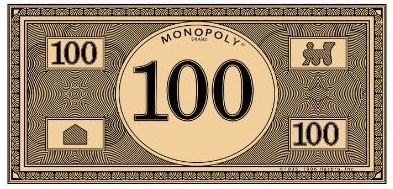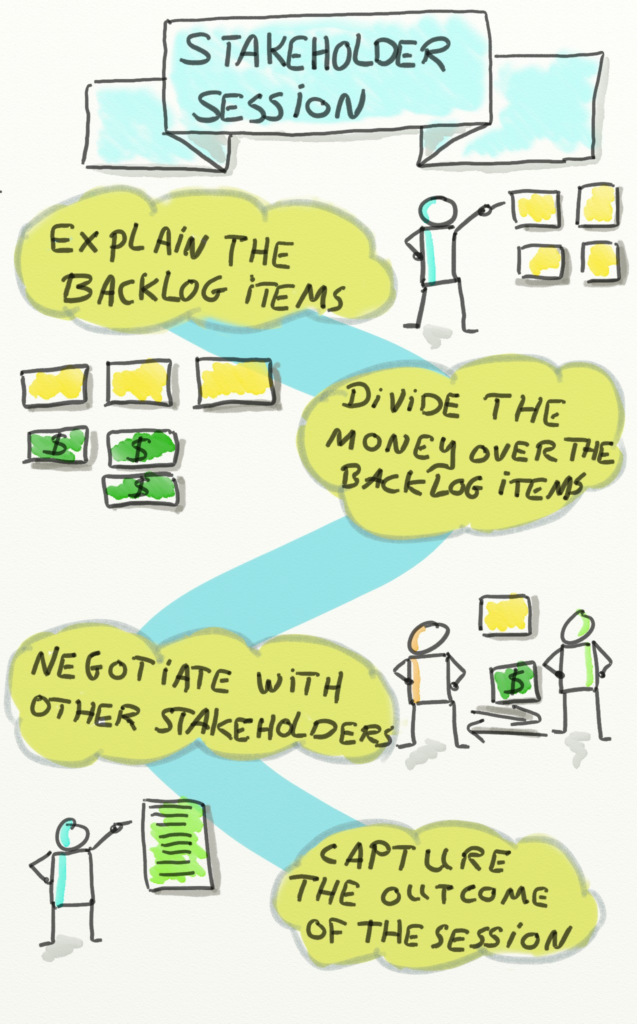As a product owner, how do you get a good insight in what’s important for your stakeholders? Also, how do you prevent becoming a go-between for your stakeholders because a stakeholder thinks his product backlog item (PBI) is the most important?
With the product owner of a team I coach we created a session for all the stakeholders. We did it digital in Mural but this also works great, even better, in a big room. During this session the stakeholders provided a clear insight on their view of the priority of the PBI’s.
I will describe here how you could do the session in a big room.
Preparations
Get all the PBI’s on pieces of paper or stickies. 1 PBI per paper. Take a room with walls you can stick the PBI’s on. Hang them side by side. Leave some room for the “money” the stakeholders are going to assign to the PBI’s.
Get some fake money. You can use Monopoly money or something else.

Make it easy on yourself and make sure all the bills have the same value. That makes counting more easy. Also it forces stakeholders to make a choice.
If you work for a company where there are several business units, and every business unit is represented by a single stakeholder, you can have a pile of money for every stakeholder. If there are more stakeholders for a business unit, perhaps you should pair them up in teams and every team gets a pile of money.
How much money you provide every stakeholder is a bit of a political thing. All stakeholders are created equal, but some stakeholders could be more equal than others. If you do this for the first time with your stakeholders, I would suggest you give every stakeholder the same amount. But if politics proscribes it’s better to favor a stakeholder, give that one a bit more. But don’t overdo it!!
How much money should you give your stakeholders? Not enough. If you have 40 items on your product backlog, provide the stakeholders with 12 notes each. So with the 100,– Monopoly note, you provide each stakeholder with 1200,– Monopoly money. This way a stakeholder cannot place a 100,– note on each of the PBI’s. The goal is to have them make choices.
If you have set the amount of notes, print them and write the name of the stakeholder on the note. This way the stakeholders cannot “borrow” money from their neighbors. And yes, that happens.
Make sure you have some rolls of tape and some stickies and markers.
The session
There are a few rounds during the session. So plan enough time for it. This way you don’t have to rush things.
Round 1
Explain all the PBI’s hanging on the wall. Make sure everyone understands them. If something isn’t clear, get the PBI clear and write the clarification on a sticky and stick that on the PBI. Let stakeholders clarify their own submitted PBI’s. They know best why it’s important, at least for them.
Round 2
The stakeholders get the time to divide the money over the PBI’s. They can decide to put all their money on one item, if they think that one is really important. Or they can put 100,– on PBI 1 and 300,– on PBI 2 and so on. It’s up to them
Round 3
The stakeholders get time to negotiate with each other. If you support me with this PBI, I will support you with that PBI. During this round money can be moved between PBI’s.
Round 4
Capture the outcome of the session. Count how much money is put on the PBI’s. Write it on a sticky and put the sticky with the amount on the PBI. Take a picture of the PBI’s with the amount.
Business value
These amounts given to the PBI’s by the stakeholders can be used in your product backlog. You can note the amount as business value for the PBI. After estimating with the scrum team you can compare the story points with the business value. If two PBI’s both have 900,– in business value but one story has an effort of 8 story points and the other of 3 story points you know what PBI provides the most business value with the least amount of effort.
How often
How often should you have such a stakeholder meeting? As a product owner you know how important it is to have frequent contact with your stakeholders. But that can also be on an individual basis. How often you should have a session like this depends on the amount of work the teams does (or teams do if you have multiple teams working from one product backlog) and how much input is provided by the stakeholders. If your product backlog changes often, you should have these kinds of sessions also more often.
Give this session a try and let me know what your experience is. Also if you have any questions, feel free to contact me.

